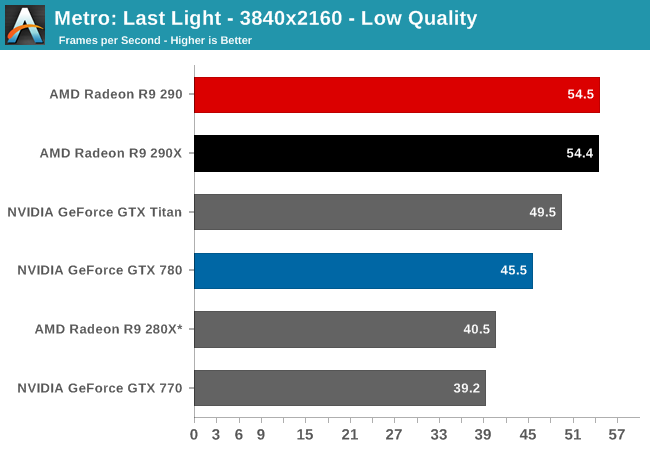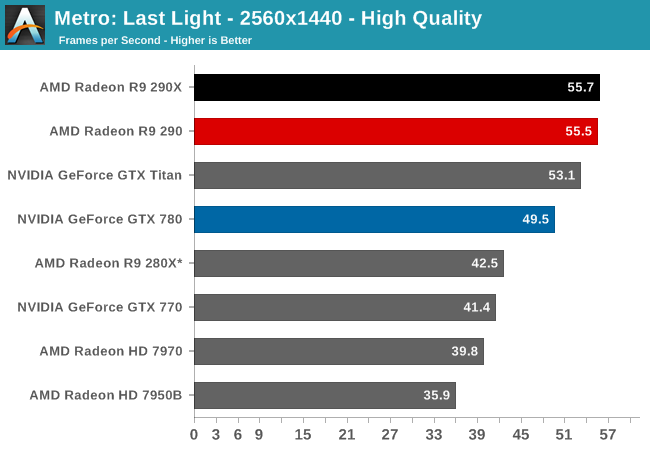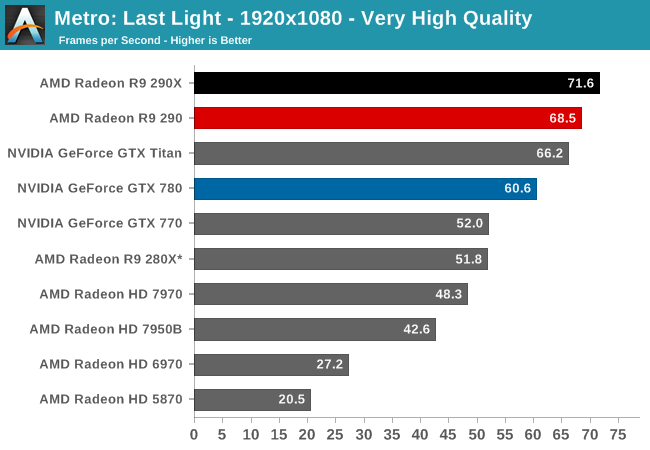The AMD Radeon R9 290 Review
by Ryan Smith on November 5, 2013 12:01 AM EST- Posted in
- GPUs
- AMD
- Radeon
- Hawaii
- Radeon 200
Metro: Last Light
As always, kicking off our look at performance is 4A Games’ latest entry in their Metro series of subterranean shooters, Metro: Last Light. The original Metro: 2033 was a graphically punishing game for its time and Metro: Last Light is in its own right too. On the other hand it scales well with resolution and quality settings, so it’s still playable on lower end hardware.



For the bulk of our analysis we’re going to be focusing on our 2560x1440 results, as monitors at this resolution will be what we expect the 290 to be primarily used with. A single 290 may have the horsepower to drive 4K in at least some situations, but given the current costs of 4K monitors that’s going to be a much different usage scenario. The significant quality tradeoff for making 4K playable on a single card means that it makes far more sense to double up on GPUs, given the fact that even a pair of 290Xs would still be a fraction of the cost of a 4K, 60Hz monitor.
With that said, there are a couple of things that should be immediately obvious when looking at the performance of the 290.
- It’s incredibly fast for the price.
- Its performance is at times extremely close to the 290X
To get right to the point, because of AMD’s fan speed modification the 290 doesn’t throttle in any of our games, not even Metro or Crysis 3. The 290X in comparison sees significant throttling in both of those games, and as a result once fully warmed up the 290X is operating at clockspeeds well below its 1000MHz boost clock, or even the 290’s 947MHz boost clock. As a result rather than having a 5% clockspeed deficit as the official specs for these cards would indicate, the 290 for all intents and purposes clocks higher than the 290X. Which means that its clockspeed advantage is now offsetting the loss of shader/texturing performance due to the CU reduction, while providing a clockspeed greater than the 290X for the equally configured front-end and back-end. In practice this means that 290 has over 100% of 290X’s ROP/geometry performance, 100% of the memory bandwidth, and at least 91% of the shading performance.
So in games where we’re not significantly shader bound, and Metro at 2560 appears to be one such case, the 290 can trade blows with the 290X despite its inherent disadvantage. Now as we’ll see this is not going to be the case in every game, as not every game GPU bound in the same manner and not every game throttles on the 290X by the same degree, but it sets up a very interesting performance scenario. By pushing the 290 this hard, and by throwing any noise considerations out the window, AMD has created a card that can not only threaten the GTX 780, but can threaten the 290X too. As we’ll see by the end of our benchmarks, the 290 is only going to trail the 290X by an average of 3% at 2560x1440.
Anyhow, looking at Metro it’s a very strong start for the 290. At 55.5fps it’s essentially tied with the 290X and 12% ahead of the GTX 780. Or to make a comparison against the cards it’s actually priced closer to, the 290 is 34% faster than the GTX 770 and 31% faster than the 280X. AMD’s performance advantage will come crashing down once we revisit the power and noise aspects of the card, but looking at raw performance it’s going to look very good for the 290.










295 Comments
View All Comments
Sunburn74 - Tuesday, November 5, 2013 - link
Too hot and too loud for any activity other than gaming on a headset. Maybe aftermarket coolers will salvage this card.megalee - Tuesday, November 5, 2013 - link
Well, I have the headphones on while gaming so I don't care about the noise. Sounds like a good deal to me. Good to see some competition!asphix - Tuesday, November 5, 2013 - link
1st -- to anyone claiming that after market coolers will solve the heat/noise issue... you are correct.. but it will come at a cost. Say hello to a $450-$500 R9 290. Only time will tell, but my guess is they will either be mediocre solutions to keep the price down, or expensive (as will need to be to deal with that kind of dissipation).2nd -- AMD has one goal and only one goal with these extreme price points and that's to get themselves out of this catch 22 situation with mantle. In order for developers to program for mantle, there needs to be a user base. The user base will grow if there is mantle. Release cards that are relatively cheap with steep trade-offs to grow userbase. I feel the next release cycle will have more expensive cards with less trade-offs (noise/heat) and even better performance. It all depends on if mantle takes off which depends on people purchasing these cards.
I love the competition! I really dislike these sacrifices AMD are making to compete with Nvidia. However, i understand why the're doing it the way they are and I hope they're successful with it.
haukionkannel - Tuesday, November 5, 2013 - link
If you compare the price of reference 7970 and aftermarket cooler version of 7970, the difference is 10-50$ Nothing too bad... This just shows how bad this AMD reference is... ingredible!http://www.tomshardware.com/reviews/radeon-r9-290-...
But we vary, there may be something fishy with AMD press cards! It may be that retail makers are making even worse job with reference cooler, but now it is time to wait some good aftermarket cooler cards!
MarkcusD - Tuesday, November 5, 2013 - link
"290 is essentially twice as loud as the GTX 780"Lol. What a POS. Seriously it may improve with some non-stock coolers, but I wouldn't touch this card.
willis936 - Tuesday, November 5, 2013 - link
If you convert to linear sound levels it's actually three times as loud. That's mostly academic though.supamark - Tuesday, November 5, 2013 - link
Actually, it's just short of 10 times as loud - it's a log scale.jonjonjonj - Tuesday, November 5, 2013 - link
i get that anand cant recommend the card because of the noise. but i think amd is going to sell a lot of these cards because in the end its all about performance and price. plus who buys a reference card anyway? on the asus cards i have owned you can turn the fan to 100% and its silent. some 3rd party card will come out with a quiet cooler that also unleashes the 290.superjim - Tuesday, November 5, 2013 - link
Wait for OEMs to get out their custom cards with the quiet/cooler open air fans and the 290 will be near perfect at $400.jb14 - Tuesday, November 5, 2013 - link
This card is like a drag race car. Pedal flat to the floor, screamingly loud, burning through petrol, pretty cheap (50W increase - crazy)! The only good thing here is the price/performance shaking things up alittle. NV could also quite happily dump an extra 50W through their cards and we could have to two screaming cards next to each other!I have an AMD card in my laptop but wouldn't consider touching this card in the desktop unless it had some seriously beefed up non-custom coolers. Let's see what the AMD partners can do to try and tame this beast!